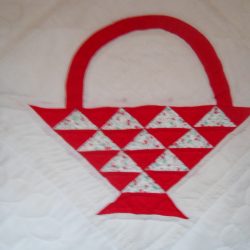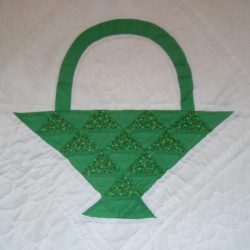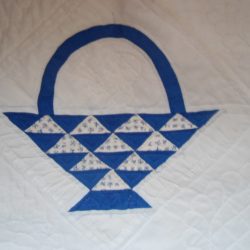An Amazing Amish Quilter
I first visited Smicksburg, Pennsylvania on the last day of summer 2016. Smicksburg is a small rural town where a small arts and crafts community coexists with the Amish and other rural folks. The shops are fun to visit: pottery, antiques, dried flowers, yarn and wool, country gifts and a small Heritage museum. Other shops flourish on the periphery of Smicksburg and include an Amish furniture shop, antiques, a country restaurant, a chocolate shop (with more than just chocolate).
I wrote about that first trip (and the second trip) but I didn’t mention the Amish farm that my friend and I passed. We saw the sign by the side of the road: “Quilt repairs.”
I thought about the handmade basket pattern quilt I bought at the annual antiques show in a mall 18 to 20 years ago (Monroeville Mall, Monroeville, PA). Some of the material had frayed so I put it away hoping to repair it one day.
I knew it would be expensive to fix and finding someone who repairs quilts is like looking for a needle in a haystack. I tried. The closest quilt “repairer” that I had found was a five-hour drive away from Pittsburgh.
On the second rip to Smicksburg, I brought it along thinking I would get an estimate. The fabric had deteriorated even more; in fact, so had the cotton batting between the quilt top and the backing. We stopped at the quilt shop which displayed some of the most beautiful quilts I have ever seen in many different colors and patterns including crazy, log cabin, postage stamp (my favorite) and more.
She has her share of customers, too.
Effie greeted us and explained how long it would take and how much and that cotton doesn’t last. The Amish have switched to cotton blends. So I decided right there and then that I would leave the quilt for Effie to repair. That was in October. She had two other quilts ahead of mine to work on so it would take as until the Christmas holidays or even early January before she could finish it. I plucked down a deposit and wrote my name and address in her guest book.
The Saturday after Thanksgiving, Effie wrote to me that she had finished the quilt. I picked it up this Saturday, December 10th (again spending the day in Smicksburg browsing and shopping).
Effie is an amazing artist; the quilt is like new. Not only are the baskets replaced in their original colors (with fresh fabric) but the quilted background was redone like the original. Effie’s mother told us that Effie used fabric that belonged to her grandmother to repair the baskets that had deteriorated (some of the baskets were in good condition).
We chatted with Effie and her mother for a while. I had never really communicated with the Amish before but it’s no different from speaking to anyone else. (I once spoke to an Amish buggy driver in Lancaster.) Her mother told us that Effie was named after a beloved aunt.
Effie works by hand, without the benefit of electricity (or running water), a computer to store her patterns and database of customers, or a cell phone to text that the quilt is ready or that she’s running a special for the holidays. We communicated by letter or face-to-face.Their way of life reminds me of the seven months I spent in my father’s village in Cyprus: no running water, electricity, etc.
And the Amish are hardy. In October, Effie and her mother greeted us walking barefoot on the hard ground. Neither wore a coat yesterday and it was not a warm day.
Yesterday, I felt like I was going through a spiritual experience fixing my heirloom quilt!
A Brief History of Quilting
Quilting was first developed in Europe during the Crusades when European soldiers discovered that Turks wore several layers of fabric quilted together under their armor.
In other parts of the world, (China, North Africa, the Middle East, and northern Europe), clothing sometimes featured patchwork stitching. In ancient China, silk was so expensive that when an article of clothing wore out, the silk was cut into pieces and sewn into patchwork clothing. Today, quilting is primarily used on bedspreads, wall hangings, place mats and the like.
A quilt is composed of a top which is made of pieces of fabric cut and sewn into a pattern. Cotton (or polyester or wool) batting is layered between the quilted top and the backing. The three layers are pinned together, the quilted design marked on the top piece and quilted by hand or by machine. The outer edges of the quilt are turned under and sewn with binding.
By the time the early colonists arrived in the New World, quilting was a common way of sewing bedding and clothing. However, only the wealthy owned them. Fabrics were imported from France and England and expensive for the average colonial family.
By the early 19th century, American manufacturing cheaply produced cotton fabrics in various colors and patterns and designs evolved over time: the medallion, crazy pattern, mosaic, and Baltimore Album or Friendship design among others.
In 1972, the Whitney Museum of American art celebrated the history of American quilts with the exhibit, “Abstract Design in American Quilts.” The Bicentennial Celebrations and the growing feminist movement influenced the theme of the exhibit which featured vintage Amish quilts. The exhibit was a success with the public.
Quilts not only became popular to make and/or own, but vintage quilts became quite collectible.
Teague, Ken. Growing Up in Ancient China. Troll Associates, Eagle Books, 1994.






